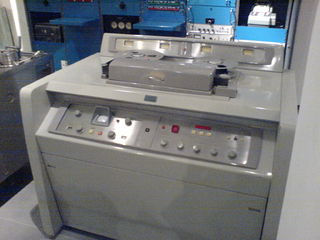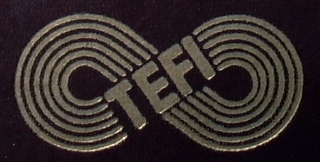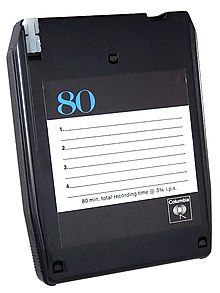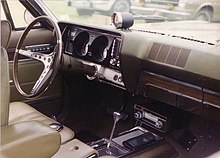
Magnetic tape is a medium for magnetic storage made of a thin, magnetizable coating on a long, narrow strip of plastic film. It was developed in Germany in 1928, based on the earlier magnetic wire recording from Denmark. Devices that use magnetic tape could with relative ease record and playback audio, visual, and binary computer data.

The Compact Cassette, also commonly called a cassette tape, audio cassette, or simply tape or cassette, is an analog magnetic tape recording format for audio recording and playback. Invented by Lou Ottens and his team at the Dutch company Philips in 1963, Compact Cassettes come in two forms, either containing content as a prerecorded cassette (Musicassette), or as a fully recordable "blank" cassette. Both forms have two sides and are reversible by the user. Although other tape cassette formats have also existed—for example the Microcassette—the generic term cassette tape is normally used to refer to the Compact Cassette because of its ubiquity.
A cassette deck is a type of tape machine for playing and recording audio cassettes that does not have a built-in power amplifier or speakers, and serves primarily as a transport. It can be a part of an automotive entertainment system, a part of a portable mini system or a part of a home component system. In the latter case it is also called a component cassette deck or just a component deck.

Reel-to-reel audio tape recording, also called open-reel recording, is magnetic tape audio recording in which the recording tape is spooled between reels. To prepare for use, the supply reel containing the tape is placed on a spindle or hub. The end of the tape is manually pulled from the reel, threaded through mechanical guides and over a tape head assembly, and attached by friction to the hub of the second, initially empty takeup reel. Reel-to-reel systems use tape that is 1⁄4, 1⁄2, 1, or 2 inches wide, which normally moves at 3+3⁄4, 7+1⁄2, 15 or 30 inches per second. Domestic consumer machines almost always used 1⁄4 inch (6.35 mm) or narrower tape and many offered slower speeds such as 1+7⁄8 inches per second (4.762 cm/s). All standard tape speeds are derived as a binary submultiple of 30 inches per second.

Monaural or monophonic sound reproduction is sound intended to be heard as if it were emanating from one position. This contrasts with stereophonic sound or stereo, which uses two separate audio channels to reproduce sound from two microphones on the right and left side, which is reproduced with two separate loudspeakers to give a sense of the direction of sound sources. In mono, only one loudspeaker is necessary, but, when played through multiple loudspeakers or headphones, identical signals are fed to each speaker, resulting in the perception of one-channel sound "imaging" in one sonic space between the speakers. Monaural recordings, like stereo ones, typically use multiple microphones fed into multiple channels on a recording console, but each channel is "panned" to the center. In the final stage, the various center-panned signal paths are usually mixed down to two identical tracks, which, because they are identical, are perceived upon playback as representing a single unified signal at a single place in the soundstage. In some cases, multitrack sources are mixed to a one-track tape, thus becoming one signal. In the mastering stage, particularly in the days of mono records, the one- or two-track mono master tape was then transferred to a one-track lathe used to produce a master disc intended to be used in the pressing of a monophonic record. Today, however, monaural recordings are usually mastered to be played on stereo and multi-track formats, yet retain their center-panned mono soundstage characteristics.

A video tape recorder (VTR) is a tape recorder designed to record and playback video and audio material from magnetic tape. The early VTRs were open-reel devices that record on individual reels of 2-inch-wide (5.08 cm) tape. They were used in television studios, serving as a replacement for motion picture film stock and making recording for television applications cheaper and quicker. Beginning in 1963, videotape machines made instant replay during televised sporting events possible. Improved formats, in which the tape was contained inside a videocassette, were introduced around 1969; the machines which play them are called videocassette recorders.

An album is a collection of audio recordings issued on compact disc (CD), vinyl, audio tape, or another medium such as digital distribution. Albums of recorded sound were developed in the early 20th century as individual 78 rpm records collected in a bound book resembling a photo album; this format evolved after 1948 into single vinyl long-playing (LP) records played at 33+1⁄3 rpm.

The 8mm video format refers informally to three related videocassette formats. These are the original Video8 format and its improved successor Hi8, as well as a more recent digital recording format known as Digital8. Their user base consisted mainly of amateur camcorder users, although they also saw important use in the professional television production field.

The Muntz Stereo-Pak, commonly known as the 4-track cartridge, is a magnetic tape sound recording cartridge technology.

PlayTape is a 1⁄8 inch (3.2 mm) audiotape format and mono or stereo playback system introduced in 1966 by Frank Stanton. It is a two-track system, and was launched to compete with existing 4-track cartridge technology. The cartridges play anywhere from eight to 24 minutes, and are continuous. Because of its portability, PlayTape was an almost instant success, and over 3,000 artists had published in this format by 1968. White cases usually meant about eight songs were on the tape.

Sound recording and reproduction is the electrical, mechanical, electronic, or digital inscription and re-creation of sound waves, such as spoken voice, singing, instrumental music, or sound effects. The two main classes of sound recording technology are analog recording and digital recording.

The Fidelipac, commonly known as a "NAB cartridge" or simply "cart", is a magnetic tape sound recording format, used for radio broadcasting for playback of material over the air such as radio commercials, jingles, station identifications, and music, and for indoor background music. Fidelipac is the official name of this industry standard audio tape cartridge. It was developed in 1954 by inventor George Eash, and commercially introduced in 1959 by Collins Radio Co. at the 1959 NAB Convention. The cartridge was often used at radio stations until the late 1990s, when such formats as MiniDisc and computerized broadcast automation predominated.

Multitrack recording of sound is the process in which sound and other electro-acoustic signals are captured on a recording medium such as magnetic tape, which is divided into two or more audio tracks that run parallel with each other. Because they are carried on the same medium, the tracks stay in perfect synchronization, while allowing multiple sound sources to be recorded at different times.

The RCA tape cartridge is a magnetic tape audio format that was designed to offer stereo quarter-inch reel-to-reel tape recording quality in a convenient format for the consumer market. It was introduced in 1958, following four years of development. This timing coincided with the launch of the stereophonic phonograph record. It was introduced to the market by RCA in 1958.

The Tefifon is an audio playback format, developed and manufactured in Germany, that utilizes cartridges loaded with an endlessly looped reel of plastic tape. It is somewhat similar to the later 4-track and 8-track magnetic audio tape cartridges, but with grooves embossed on the tape, like a phonograph record. The grooves were embossed in a helical fashion across the width of the tape, in a manner similar to Dictaphone's Dictabelt format. The grooves are read with a stylus and amplified pickup in the player's transport. A Tefifon cartridge, known as a "Tefi", can hold up to four hours of music; therefore, most releases for the format are usually compilations of popular hits or dance music, operas, and operettas. Tefifon players were not sold by television and radio dealers in Germany, but rather sold directly by special sales outlets affiliated with Tefi.

Electric music technology refers to musical instruments and recording devices that use electrical circuits, which are often combined with mechanical technologies. Examples of electric musical instruments include the electro-mechanical electric piano, the electric guitar, the electro-mechanical Hammond organ and the electric bass. All of these electric instruments do not produce a sound that is audible by the performer or audience in a performance setting unless they are connected to instrument amplifiers and loudspeaker cabinets, which made them sound loud enough for performers and the audience to hear. Amplifiers and loudspeakers are separate from the instrument in the case of the electric guitar, electric bass and some electric organs and most electric pianos. Some electric organs and electric pianos include the amplifier and speaker cabinet within the main housing for the instrument.
Bernard August Cousino was an American music technology inventor. He is known for inventing an endless loop tape cartridge design in 1952, known as the Audio Vendor, patented under US2804401A. The tape is pulled from the inside of a loose tape roll making it spin to wind the returning tape onto the roll again. Initially, this mechanism was mounted on a reel to reel tape recorder. Later Cousino developed a plastic housing to be hung up on some tape recorders. First, the magnetic coating was wound to the inside of the reel. This cartridge was marketed by John Herbert Orr as the Orrtronic Tapette. Newer cartridges had magnetic coating wind of the tape outside the reel, which required a special recorder to operate it, but offers comfortable simple inserting the cartridge without threading the tape. This more compact cartridges do not require any bottom spare for the tape head assembly. That would inspire George Eash to make the Fidelipac tape cartridge, which itself would inspire the Stereo-Pak tape cartridge.
George H. Eash was an American inventor of several magnetic tape audio cartridges having a single tape reel. In 1950s he worked next desk to Bernard Cousino, who invented the endless tape loop, using it at first on an open reel. Eash created further cartridges using this tape loop like the Fidelipac, also known as "NAB-Cartridge" or even "cart" and used in broadcast, and as a consultant of Earl "Madman" Muntz the 4-Track cartridge, known as the Muntz Stereo-Pak or CARtridge. With the Lear 8-Track cartridge Eash's patent plea failed.
An endless tape cartridge is a tape cartridge or cassette that contains magnetic audio tape that can be played in an endless loop, without the need to rewind to repeat.



















